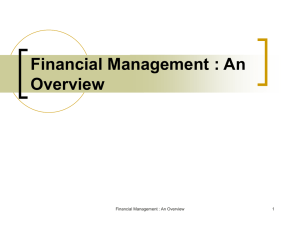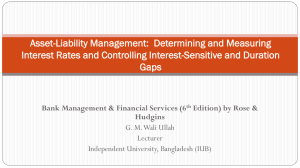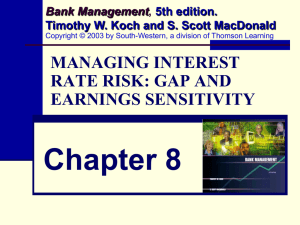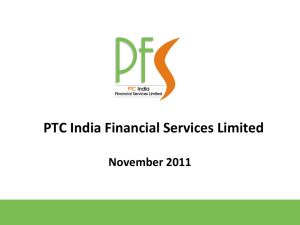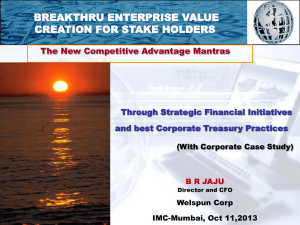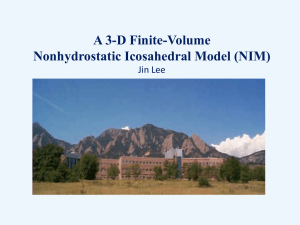Sequence of Steps in ALM (Asset / Liability Management)
advertisement
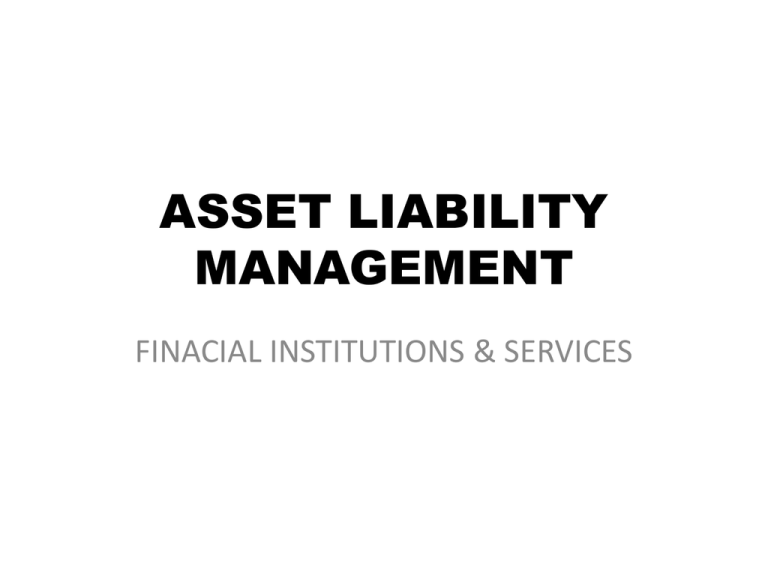
ASSET LIABILITY
MANAGEMENT
FINACIAL INSTITUTIONS & SERVICES
Sequence of Steps in ALM (Asset /
Liability Management)
ALM refers to simultaneous management of assets and liabilities of any
financial institution to achieve its target RONW ( ROE) .
HOW IS IT DONE?
• 1. Managing the size of NIM
• 2. managing the risk of NIM
Step1. Managing the size of NIM
• Set a RONW target for next year ( because co’s owners are most important,
and the return on their investment is NI / OE)
• Given the regulation about Capital Adequacy and Tax rate, set NIM target
for The next year to achieve the target RONW.
• Given the NIM target , set the targets for r (effective annual yield on
assets) & c (effective annual yield on liabilities)
• Given the targets r on assets, decide the amounts and yields (‘r’s) of
different types of assets you want to have in your balance sheet . Similarly
given the target ‘c’ on liabilities, decide the amounts and yield (‘c’s) of
different types of liabilities you want to have in your balance sheet .
Step 2. Managing the risk of NIM
1. By Restructuring the Balance Sheet
• a) Rate sensitive GAP management
• b) Duration GAP Mgmt.
• Please note the restructuring needed to manage rate
sensitive GAP may not be suitable to manage
Duration GAP. So there is possibility that the
management strategy for rate sensitive gap ( also
called funding GAP, Maturities mismatching GAP)
may go counter to the strategy for Duration GAP
management; and manager may face a dilemma as
to which GAP to manage and which GAP to leave
un managed.
2. Without restructuring the Balance Sheet: by using financial
derivative such as :
• i-rate Futures contracts
• i-rate Options contracts
• i- rate Swap contracts
• i-rate swap options
• i-rate Caps, floors
• you can achieve the same desired future CFs (cash flows)
pattern by taking position in the above stated derivative
contracts as you would achieve by restructuring the balance
sheet.
Exercise:
• A financial Institution has target for RONW=30%. It earns 15% yield (r )on its
assets, its tax rate is 60% . Govt.’s capital adequacy requirement is minimum
10% , its NIE / TA ratio is 2% and its TL / TA ratio = 90%.
Required:
• What should be its cost of funds to achieve target RONW? (i.e. c)
• What should be is NIM to achieve target RONW?
• If Govt. changes the Capital Adequacy rules and brings it at par with
the int’l standards (4%), then what RONW it can expect to earn,
keeping the target NIM same as in no. 2 above.
Solution
1).NIM= {RONW * NW/TA * 1/(1-t)} + NIE/TA = r - (c * TL/TA)
{0.3*0.10*1/(1-0.6)} + 0.02 = 0.15 - (c* 0.9)
0.095=0.15-0.90c
0.095 - 0.15= -0.90c
-0.055= -0.90c
0.0611=c (i.e. 6.11%)
2. NIM= { RONW * NW/TA* 1/(1-t)} + NIE/TA
= {0.3 * 0.1 * 1 / (1-0.6)} + 0.02
= 0.095 i.e. 9.5%
3. NIM= { RONW * NW/TA * 1/(1-t)} + NIE/TA
0.095= { RONW * 0.04 * 1/(1-0.6)} + 0.02
0.095 = (RONW* 0.1) + 0.02
0.095 - 0.02 = ( RONW * 0.01)
0.075/0.01= RONW
0.75 =RONW i.e 75%
RESULT:
When Capital Adequacy from 10% to 4%:
• RONW from30% to 75%
• Financial Leverage (TA / NW) is from 1/10% =10 time to 1/ 4%= 25 time
• When FI Financial leverage its RONW
• In good economic times , when revenue , high Fin leverage RONW
• In bad economies when revenue , high Financial Leverage causes in RONW
How to Financial Leverage ?
• (TA/NW) i.e NW Multiplier ratio
• (TL/ TA) i.e Debt Ratio
• (TL / NW) i.e Debt Equity Ratio
• to TA /NW , you can NW by : issuing shares to raise fresh equity, or increasing
NI and therefore RE, or by only decreasing dividends and thus increasing RE
without increasing NI. A FIs’ financial leverage should be adjusted according to the
economic conditions in the country, and should be such that it does not violate
minimum capital adequacy requirements.
• In Recession: it is sensible to have Leverage and in Boom Leverage; but ability
to correctly predict recession or boom for the next year is self questionable; please
note that not many economist were correct in 2007 in predicting the ensuing
recession of 2008-2009.
• However, apart from economic conditions other variables have to be considered as
well.
• A bank can TL by decreasing the deposits by i-rates on deposits and thus
discouraging depositors, or by minimum balance requirement of depositors ,
again to discourage depositors.
EXERCISE
A FI institution has c of 7% and r of 11%. It is operating at minimum capital
adequacy of 4%. Tax rate is 50%. Its NIE / TA ratio is 3%.
REQUIRED:
1. TL/TA ratio
2. NIM it can earn
3. RONW it can earn
4. If this bank has a target of 25% for its RONW then what NIM should it earn?
5. To achieve 5% NIM, what yield on assets this bank should earn?
6. What was the required %age change in NIM to achieve target RONW of 25%
7. Increasing NIM 16.82% caused what %age change in RONW
8. To achieve 16.82% increase in NIM, you needed to make what %age change
in yield on assets ( r )?
Solution
1) NW /TA is given 4%.
TA = TL + NW.
TA / TA = TL / TA + NW /TA
1 = TL /TA + 0 .04.
TL /TA = 0.96
2) NIM = r - c * TL/TA.
= 11% - 7%*0.96.
=11% - 6.72%.
= 4.28%
3) NIM = [ RONW * NW / TA * 1 / ( 1 – T)] + NIE /TA
4.28% = [RONW * 4% * 1 / (1 -0.5)] + 3%.
4.28% = [RONW * 4% * 2] + 3%
4.28% = [RONW *8%] + 3%
4.28% - 3% = RONW * 8%
1.28% / 8% = RONW
0.16 = RONW
= 16%
Solution
4) NIM = [RONW * NW / TA * 1 / (1 – T)] + NIE / TA
= [0.25 * 0.04 * 1 / (1 –0.5)] + 0.03
= [ 0.02] + 0.03
= 0.05 = 5%
5) NIM = r – c* TL / TA
0.05 = r - 0.07 * 0.96
0.05 = r - 0.0672
0.05 + 0.0672 = r
= r = 11.72%
6) (0.05 – 0.0428) / 0.0428 = 16.82%
7) ( 25% - 16%) / 16% = 56.25%
8)(11.72% - 11%) / 11% = 6.54%
NOTE: A 6.54% increase in r caused 16.82% increase in NIM, and 16.82% increase
in NIM caused 56.25% increase in RONW. This is a prove that FIs are highly
leveraged businesses, and minor improvements on revenue earning side have
magnified impact on return for owners; the same is true for cost cutting, a
slight decrease in cost of funds would have magnified impact on RONW.
